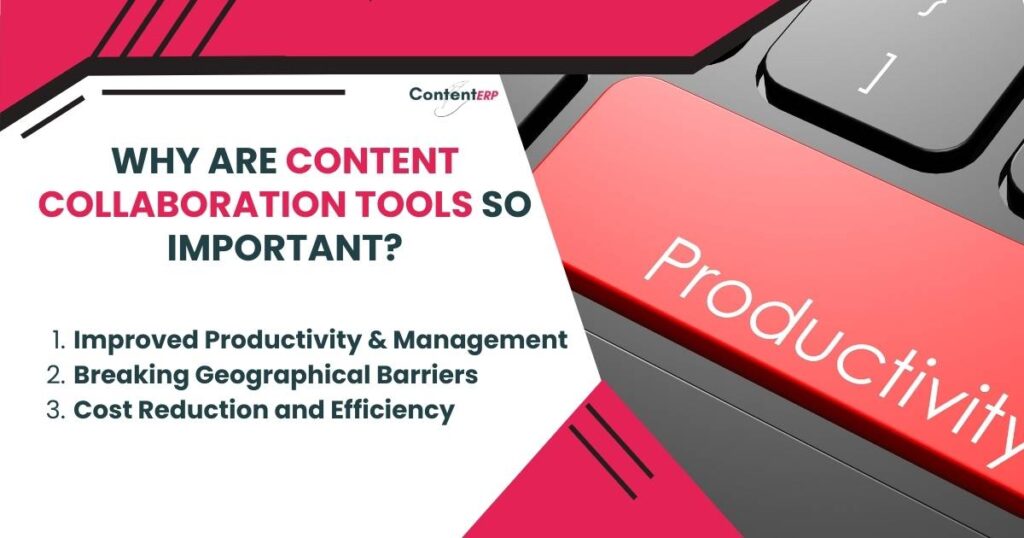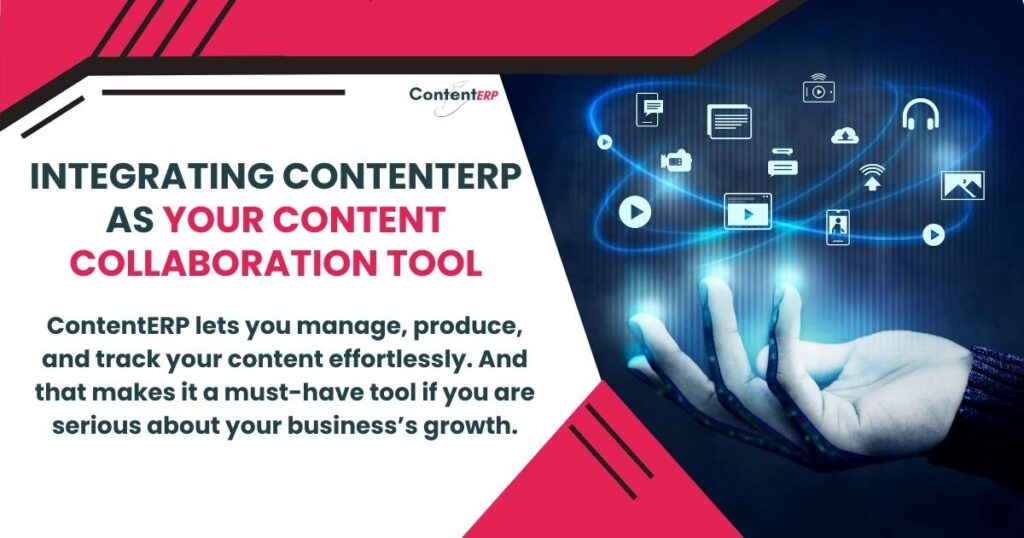In today’s business world, collaboration is the only thread that keeps all your shining ideas, detailed strategies, and goals connected together. As Henry Ford wisely stated, “Coming together is a beginning, staying together is progress, and working together is success.” His philosophy makes perfect sense when we take a look at content collaboration tools – the digital softwares that make your idea actually happen.
This is an era where almost 16% of companies are now working remotely, so the relevance of content collaboration tools has simply skyrocketed. Hence, we felt the need to provide you with our top 8 expert tips to evaluate and choose the content collaboration tools that are actually fruitful for your business.
Are you ready to take your productivity to the next level? Keep reading then.
What Exactly Are Content Collaboration Tools?
In the simplest of words, content collaboration tools are softwares that let you work together with your own team members, regardless of their physical location. These softwares have functionalities that can include file sharing, real-time communication, etc. to help you complete a project in the best collaborative fashion possible.
These tools are act digital meeting rooms where your team will come together to create, edit, and manage digital content. And believe us, they are more common and crucial than you can really think. You see, it’s reported that around 83% of professionals depend on technology for teamwork. So which softwares do they primarily use? The answer is content collaboration tools.
Roles and Functions in Different Industries
- In creative industries, these tools assist in developing, reviewing, and finalizing visual content, supporting tasks like graphic design and video editing.
- In IT and project management, they help in documenting, tracking changes, and coordinating software development or project planning.
- In marketing and content creation, they help with planning, executing, and monitoring content strategies.
Why Are Content Collaboration Tools So Important?
- Enhanced Productivity: By streamlining communication and project management, these tools, not just a little, but hugely increase team productivity. McKinsey did a survey recently and came to the conclusion that effective communication and collaboration through social technologies could raise the productivity of high-skill knowledge workers by 20-25%. Imagine raising your profits by this much. Won’t that be a gust of unbelievable and fresh air?
- Breaking Location Barriers: There are over 5.3 billion internet users worldwide. Well, that also means teams are often spread across the globe. These tools help you close those distance those gaps and enable your teams to work as if they’re in the same room.
- Cost Reduction and Efficiency: By using these tools, you don’t have any need left for physical meetings and travel. And that means a huge cut in operational costs while boosting efficiency.

So now we know what content collaboration tools are and their crucial importance, it’s time to know how to choose the best ones for your team. You have to focus on two key aspects: the overall requirements of your team and your budget constraints.
Assess Your Team’s Needs Before Choosing Content Collaboration Tools
Before diving into the tool selection, it’s absolutely crucial to understand your team’s specific needs first. What are your exact needs? What do you primarily require a platform for? File sharing, project management or real-time communication or anything else entirely?
Here’s what you should consider first about your team before choosing your software:
a) Team Dynamics and Workflow
Take an in-depth look at the nature of your team’s work. Are you a fast-paced marketing team that needs a channel for constant communication and rapid content turnaround? Or are you perhaps a part of the software development team that’s looking for some project tracking features? Understanding these dynamics and requirements is crucial to help you decide and choose. Your workflow will tell you what your pain points are.
b) Communication Styles and Preferences
Are you a picky person? What’s your or your team’s preferred style of communication? Instant messaging, emails, or face-to-face meetings? Softwares like Slack or Microsoft Teams offer you various communication channels so they can be used to cater to all of your diverse communication preferences.
c) Team’s Budget – Cost vs. Value
As a businessman, we know your biggest fear is money spent without a purpose or value. Budget constraints are definitely a thing, but you have to weigh the cost against the potential value and ROI of your tool. Free tools might be tempting, but let’s be real. But they often come with limitations in features or scalability so that renders them almost useless.
Here’s what can help you choose:
Scalability and Flexibility: Make sure that the tool you choose can scale with your team’s growth and grow with you. So investing in a slightly more expensive tool that can grow with you and your evolving needs might just be more cost-effective in the longer run.
Trial Periods and Demos: Wanna try first? Many tools offer free trials or demo versions so pick those and see which one fits best for your team before buying it.
Evaluating Features of Content Collaboration Tools
When choosing the best content collaboration tools for your team, evaluating the key features is also crucial. Let’s delve into these features to ensure you make an informed decision.
1. File Sharing and Storage
Think about it: we’re in a world where around 2.5 quintillion bytes of data are created each day. That’s an absolutely mind boggling, staggering amount! And in this sea of data, file sharing and storage are crucial for you and your team in content collaboration.
They make sure that the right information is accessible at the right time and place. Can you imagine the huge boost in productivity when your team members can access, edit, and store files from anywhere at all?
What to Look For: When evaluating file sharing and storage capabilities, focus on:
- Cloud-Based Solutions: These offer remote access and enable your team members to work from anywhere.
- Security Measures: Data is probably the most sensitive entity right now in the world, that’s a fact. So encryption and secure backup options should be non-negotiable for you.
- Storage Capacity: Make sure that the tool you have chosen can handle your team’s storage needs without you having to update your plans or packages.
- Large File Handling: The tool should effortlessly manage large files. This is a very common requirement in many projects.

2. Version Control
Version control is like a safety net of digital collaboration. It gives you a historical record of the project’s progress and enables your team to track any changes, identify who made them, and understand the exact context behind each edit. This feature is crucial if you wanna maintain the document integrity and prevent the chaos of multiple conflicting versions.
In a digital workspace, where 30% of the day is spent searching for information, version control also saves time and keeps a neat historical record of the documents. Time is money, right? Here’s your money saved.
What to Look For: Effective version control systems should offer:
- Comprehensive Change Logs: Understanding who made what changes and when.
- Restoration Capabilities: Handy for those ‘oops’ moments when you need to revert to a previous version.
- Transparency and Accountability: Ensuring that every team member’s contributions are visible and traceable so you know exactly who contributed what to the project.
3. Team Communication
Let us paint a picture for you: A team spread across four continents, working on a single project. Without a smooth communication process, it’s never going to work. You’ll be trying to solve a puzzle blindfolded without any solid communication medium.
Clear and efficient communication directly translates to a successful team collaboration. It will help everyone in your team to stay updated with the project goals and contribute effectively in the best possible way. In the digital age, good communication tools are probably the most effective real-time problem-solving platforms for everyone.
What to Look For: Choose tools that provide:
- Integrated Messaging Systems: For quick, contextual conversations.
- Commenting and Annotation Features: To enable team members to leave feedback directly on the content.
- Real-Time Notifications: To keep everyone updated on project developments and changes.

4. Project Management
In the world of project management, you get the best out of your team only if you keep the train on the tracks. For a digital content manager, t’s a juggling act of tasks, deadlines, resources and whatnot.
A good content collaboration tool helps you manage this juggling act with grace. You get to make sure that projects don’t just get completed, but shine in their completion. From brainstorming ideas to deadline tracking, these features help your projects progress smoothly, resources are utilized efficiently, and goals are met within set timelines.
What to Look For: A productive project management tool should include:
- Task Allocation and Tracking: Ensuring every team member knows their responsibilities.
- Progress Monitoring: Offering a bird’s-eye view of the project’s advancement.
- Resource Management: Enabling efficient distribution and use of resources.
- Deadline Management: Keeping the project on schedule and alerting to potential delays.
5. Integration with Other Tools
In a world where 89% of companies are investing in digital transformation, the integration of various tools in content collaboration platforms has now become a downright necessity for almost all businesses. You can’t have 100 different, standalone softwares every step of the way. So integration will make sure that your content collaboration tool works perfectly in harmony with other applications, be it social media channels, CMS, email tools, or workflow automation like Zapier, HubSpot, Slack, etc etc.
The result? Reducing the need to switch between applications. The effect? Streamlining your workflow and enhancing efficiency.
What to Look For: Here’s what your content collaboration tool should include:
- Seamless CMS Integration: Look for content collaboration tools that integrate with popular CMSs for one-click publishing.
- Broad Application Compatibility: Your chosen tool should work well with a range of applications, including social media and email platforms.
- Workflow Automation: Integration with tools like Zapier can automate parts of the content creation and distribution process, saving valuable time and effort.

6. Consider Ease of Use
An intuitive interface in content collaboration tools does not just help you get around with ease, it also lets you adapt and be more productive. A user-friendly interface makes sure that team members can quickly learn the tool without wasting a lot of time. This ultimately improves the overall efficiency of the team.
What to Look For: Your content collaboration tools should be:
- User-Friendly Interface: The tool should be straightforward to navigate and use.
- Quick Access to Features: Essential features should be easily accessible for all – nothing too complex or hefty.
- Ready to Use With Minimal Training: The tool should require minimal training so you’re your team members can get up to speed very quickly.
7. Assess the Security Features
Cyber threats are now steadily on the rise, so for you, the security of a content collaboration tool is non-negotiable. A secure tool protects sensitive data and maintains the integrity of your content and communication.
What to Look For: Your content collaboration tools should have:
- Data Encryption: Your precious data should stay safe and encrypted both in use and at rest.
- Secure Backup Options: One of the most crucial requirements to protect you against data loss.
- Access Controls: To manage who can view and edit documents.

8. Considering Cost
Cost is a crucial consideration for any business tool. It’s not just about the initial price tag; it’s about the value it brings relative to its cost. A tool that offers a flat pricing structure with unlimited users, for example, can be more economical in the long run, especially for growing teams.
What to Look For: The features of your content collaboration tools should be:
- Cheaper With Transparent Pricing: Avoid excessively expensive tools or those with hidden fees.
- Scalable As & When Needed: The tool should accommodate your team’s growth without significant cost hikes.
- Value for Money: Assess whether the features and benefits justify the cost.
So there you have it, our expert tips to choose the best content collaboration tools for your content management lifecycle. Keep in mind what to look for and how to choose these as they might become the very pillars your success will stand on.
Ready to know about the best content collaboration tool now?
Why ContentERP is Your Ideal Content Collaboration Tool
ContentERP is a revolutionary content collaboration software that has been designed to streamline your management of niche websites and blogs. We have focused on creating an exceptionally smooth content workflow so that you can manage the content creation process from keyword research to publication without any hiccups at all.
- Streamlined Content Management: Centralize your entire content process from research to publication, perfect for niche site owners and bloggers.
- Team Collaboration Made Easy: Assign roles and build teams efficiently, fostering seamless collaboration.
- Drip-Fed Content Queue: Keeps your team consistently supplied with tasks, ensuring steady content flow.
- Comprehensive Site Management: Control multiple sites from one platform, a game-changer for managing various projects.
- Advanced Keyword Research Tools: Improve your SEO strategy with built-in keyword research tools to help you top those search engine rankings.
- Insightful Analytics: Gain valuable insights into your content’s performance like your team’s worked hours, expenditure and revenue.
- Efficient Time Tracking: A Chrome Extension Time Tracker monitors work hours to help you do a comprehensive productivity analysis.
Hence, ContentERP lets you manage, produce, and track your content effortlessly. And that makes it a must-have tool if you are serious about your business’s growth.

Conclusion
Our digital world is progressing at an unbelievable pace, so selecting the right content collaboration tools may very well be the difference between success and failure for your business. By focusing on the key features of collaboration tools mentioned in this blog, you can give yourself the perfect chance to improve and enhance your workflow productivity in a significant way.
Remember that a tool that meets your team’s needs and objectives is not just a software but an investment in your team’s future success.
And with its powerful features like team collaboration and insightful analytics, ContentERP is your best option to streamline your content management process like never before. So are you ready to transform the way you manage your content?
Sign up today at ContentERP and start experiencing a new level of control over your content workflow.

